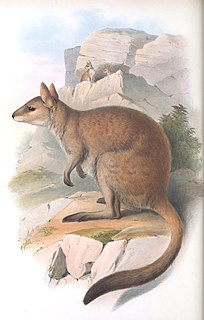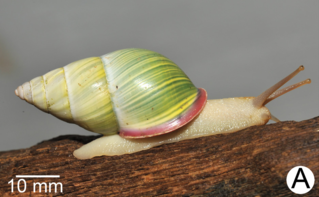Related Research Articles

The monjon is a common name for the species Petrogale burbidgei, the smallest of the rock-wallabies (Petrogale), found in the north-west Australia. They are restricted to a small area of the Kimberley region and on nearby islands in the Bonaparte Archipelago.

Nabarleks, are a tiny species of macropod found in northern Australia. They are a shy and nocturnal animal that resides in rocky hollows and forages in the surrounding area. Their diet is grasses, sedges, and ferns found in and around their scrub covered refuges. They are distinguished by a reddish tinge to the mostly grey fur and a distinct stripe at the cheek. They move with great speed and agility when observed, with a forward leaning posture and a bushy tail that arches over the back.

Amphidromus is a genus of tropical air-breathing land snails, terrestrial pulmonate gastropod mollusks in the family Camaenidae. The shells of Amphidromus are relatively large, from 25 mm (0.98 in) to 75 mm (3.0 in) in maximum dimension, and particularly colorful. During the 18th century, they were among the first Indonesian land snail shells brought to Europe by travelers and explorers. Since then, the genus has been extensively studied: several comprehensive monographs and catalogs were authored by naturalists and zoologists during the time period from the early 19th to the mid 20th centuries. Modern studies have focused on better understanding the evolutionary relationships within the group, as well as solving taxonomic problems.
Amplirhagada is a genus of air-breathing land snails, terrestrial pulmonate gastropod mollusks in the family Camaenidae. This genus is endemic to the Kimberley region in northwesternmost Western Australia, where it represents the most species-rich genus of land snails.
Carinotrachia is a genus of medium-sized air-breathing land snails, terrestrial pulmonate gastropods in the family Camaenidae.
Ningbingia is a genus of land snails in the family Camaenidae. This genus is endemic to Kimberley in Western Australia.
Torresitrachia is a genus of air-breathing land snails, terrestrial pulmonate gastropod mollusks in the family Camaenidae.
Westraltrachia is a genus of land snails in the family Camaenidae.

Camaenidae is a family of air-breathing land snails, terrestrial pulmonate gastropod mollusks in the superfamily Helicoidea, the typical snails and their allies. This is one of the most diverse families in the clade Stylommatophora.

The Bonaparte Archipelago is a group of islands off the coast of Western Australia in the Kimberley region, within the Shire of Wyndham-East Kimberley. The closest inhabited place is Kalumburu located about 100 kilometres (62 mi) to the east of the island group. The archipelago was named by the Baudin expedition on 16 August 1801 after Napoleon Bonaparte, First Consul of France.

Bigge Island is an island off the coast of the Kimberley region in Western Australia, within the Shire of Wyndham-East Kimberley.
Gnarosophia bellendenkerensis is a species of air-breathing land snail, a terrestrial pulmonate gastropod mollusk in the family Camaenidae.
George Alan Solem, known professionally as Alan Solem, was an American malacologist, a biologist who studied mollusks.

Amphidromus perversus is a species of air-breathing land snail, a terrestrial pulmonate gastropod mollusk in the family Camaenidae.
Chloritis biomphala is a species of land snail, a terrestrial pulmonate gastropod mollusk in the family Camaenidae.
Chloritis togianensis is a species of air-breathing land snail, a terrestrial pulmonate gastropod mollusk in the family Camaenidae.
Chloritis planorbina is a species of air-breathing land snail, a terrestrial pulmonate gastropod mollusk in the family Camaenidae.
Kimberleymelon tealei is a species of air-breathing land snail, a terrestrial pulmonate gastropod mollusk in the family Camaenidae. Kimberleymelon tealei is the only species in the genus Kimberleymelon.
Carinotrachia admirale is a species of air-breathing land snail, a terrestrial pulmonate gastropod mollusk in the family Camaenidae.

Middle Osborn Island is an island off the coast of the Kimberley region in Western Australia.
References
| | This Camaenidae-related article is a stub. You can help Wikipedia by expanding it. |